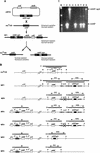Characterization of the mIHF gene of Mycobacterium smegmatis
- PMID: 9765584
- PMCID: PMC107601
- DOI: 10.1128/JB.180.20.5473-5477.1998
Characterization of the mIHF gene of Mycobacterium smegmatis
Abstract
Integration of mycobacteriophage L5 requires the mycobacterial integration host factor (mIHF) in vitro. mIHF is a 105-residue heat-stable polypeptide that is not obviously related to HU or any other small DNA-binding proteins. mIHF is most abundant just prior to entry into stationary phase and is essential for the viability of Mycobacterium smegmatis.
Figures



References
-
- Aviv M, Giladi H, Schreiber G, Oppenheim A B, Glaser G. Expression of the genes coding for the Escherichia coli integration host factor are controlled by growth phase, rpoS, ppGpp and by autoregulation. Mol Microbiol. 1994;14:1021–1031. - PubMed
-
- Cole S T, et al. Deciphering the biology of Mycobacterium tuberculosis from the complete genome sequence. Nature. 1998;393:537–544. - PubMed
Publication types
MeSH terms
Substances
Associated data
- Actions
Grants and funding
LinkOut - more resources
Full Text Sources

